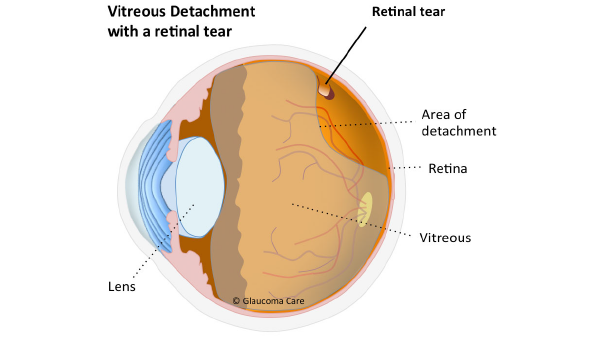Retinal tears & Detachments
Floaters & flashes are mostly harmless but can indicate retinal tears & detachments.

The vitreous body of the eye is normally pressed up against the retina wall. Retinal tears can occur when the size vitreous body of the eye decreases with age. A small piece of the retina can come off with it, creating a tear in the retina. Retinal tears need to be dealt with urgently to prevent vitreous fluid escaping from the eye. This fluid can cause the vitreous body to come away from the retina, known as a retinal detachment which can cause vision loss.
What are the symptoms of retinal tears & detachments?
If you notice a sudden increase in floaters or flashes and your vision is impacted this may be a sign of a retinal tear. A shadow appearing in your peripheral vision or a sudden decrease in vision could be a symptom. It is important to contact an ophthalmologist immediately.
What are floaters?
Floaters are common and generally harmless. They often appear as small dark squiggly shapes that briefly drift across your vision. These may be more noticeable against clearer backgrounds such as the sky. A sudden increase in floaters may indicate a more serious retinal tear.
What are flashes?
Flashes appear as a small arc-like flash of light in the peripheral vision. Flashes are caused by the fine fibres from the shrinking vitreous body that fills the eye pulling on the retina. If flashes begin to occur more frequently and persistent it could be a sign of more serious retinal issues.
How are retinal tears & detachments diagnosed?
A dilated exam involves your ophthalmologist placing drops in your eyes to enlarge the pupils. This provides a bigger window to look through and comprehensively examine the back of your eye using a special magnifying lens. Through this lens, the vitreous body will be evaluated and the peripheral retina will be thoroughly assessed, as this is where most retinal tears occur.
What are the treatment for retinal tears & detachments?
Small tears are primarily treated with laser treatment. A laser beam is aimed through the pupil and focused around the tear. Tiny burns are created around the tear to ‘wall off’ the tear and prevent a retinal detachment.
